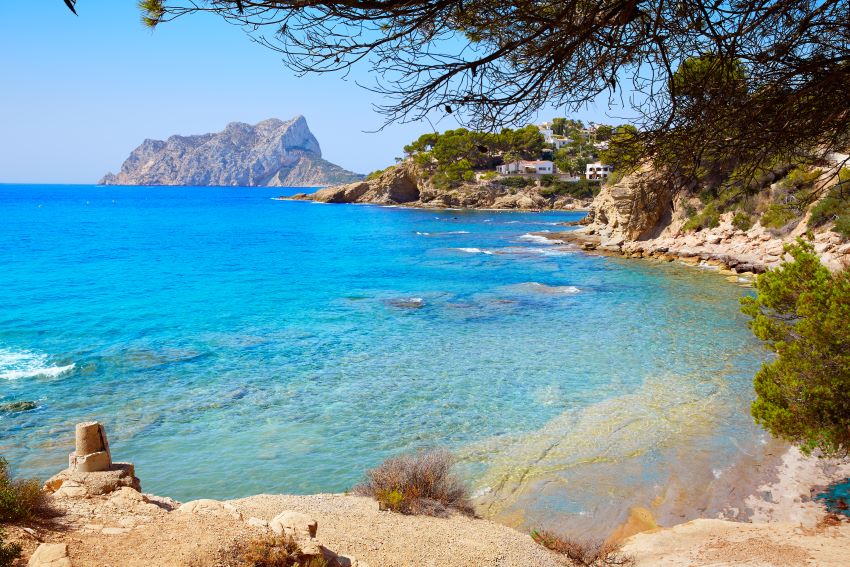
The ecological promenade of Benissa is one of the great tourist attractions of the coast of Alicante and the Costa Blanca. It is located in the municipality of Benissa (one of the 12 most beautiful villages of the Costa Blanca), hence its name, and connects the different coves of this town located in the Marina Alta, in the northwest of the province of Alicante. We explain in detail how to enjoy this scenic and environmental itinerary that is just 30 minutes drive from Camping Armanello.
Characteristics of Benissa’s ecological promenade
The path of the Ecological Walk of Benissa is a linear route of 2.5 kilometers long that can be done in a simple way, with family and children. The creation of this route in Benissa as an ecological route responds to the joint desire of the Directorate General of Coasts and the Town Hall of the town to publicize the rich landscape and biodiversity of the coast.
The coves and beaches of this Alicante municipality are of great ecological value and beauty. The route is divided into three sections that respect populations of endemic species and are characterized by communities with protected species.
The different obstacles in the itineraries are overcome with stairs. The duration to complete the entire ecological route is an hour and a half for each section, because in all of them there are information panels that help to interpret the landscape. The three sections are: Cala Bassetes-Aula de la Mar, Aula de la Mar-Cala Pinets, Cala Llobella-Advocat.
The Passeig Ecológic de Benissa is one of the 4 Blue Paths awarded in 2022 in the province of Alicante by the Association of Environmental Education and Consumer(ADEAC).
The cliffs of Benissa
The ecological route of Benissa presents the cliffs as the main protagonist. These rock formations on the coast give rise to a marine ecosystem in which protected herbaceous species such as the bigheaded thyme or the cat’s head rockrose stand out.

One of the most interesting points along the route is the Flora Microreserve in Cala Bassetes and Cala Fustera, declared as such to ensure the protection and monitoring of the species that live there. Throughout the itinerary, visitors can contemplate plant species adapted to the Mediterranean climate, such as pines, esparto grass, sea fennel or albaida.
The fleet section includes seagulls, insects, reptiles and small mammals. The underwater fauna deserves a special mention , with shells, seaweed and limpets at the base of the cliffs. Clams, anemones, octopus and sole are found in the sandy marine areas farther away from the rocks. A final attraction is the Posidonia oceanica meadows that form underwater forests and indicate the good state of conservation of the coast.
Who can walk along the ecological promenade of Benissa?
This itinerary is adapted to all types of public, except those with reduced mobility. The total length of the route is less than three kilometers, but the ideal is to complete the entire trail in an immersive experience, observing the interpretive panels and understanding the landscape.
A variant of the walk is to make it circular, which involves raising the total distance over nine kilometers. For this option, the time to dedicate is about three hours, without counting the stops. The degree of difficulty is a bit more complicated, although it is also accessible for children, pets and families.
What you need to know to walk the ecological route of Benissa
This itinerary totals of 21 interpretive panels, which also means 21 stops. The total number of arrests is divided into seven in the section Cala Bassetes-Aula de la Mar, eight in the section Aula del Mar-Cala Pinets, and six in the path that runs from Cala Llobella to Advocat.
Section Cala Bassetes-Aula de la Mar
This first part of the walk starts at the Benissa Playa Tourist Information Office. It has an extension of 0.7 kilometers one way and is equipped with seven explanatory panels. One of the most remarkable elements are the remains of an old rough stone quarry.
The final point is the Bassetes Cove, which is perfect for snorkeling. snorkeling . The interpretative panels offer information about the cat’s head jarilla, about the weathering processes in Bassetes Cove or about bivalves present in the Mediterranean. Visitors can also stroll around Cala Fustera.
Sections Aula de la Mar-Cala Pinets
The stretch to Cala Pinets also runs through Cala Fustera, which is the most accessible of all those that can be seen. This section extends for 0.5 kilometers and moves away from the coast to pass through the Fanadix green zone.
Here visitors will find eight information panels with details about the Posidonia Oceanica meadows, the coastal geomorphology and the cliff as an ecosystem or the rocky bottoms.
Stretch Paseo Llobella-Advocat
This part is not connected to the other two sections. The previous section ends in Cala Pinets and further north, already in Cala Llobella, begins the next section that reaches Cala Advocat.
This area also passes next to a green area and offers picnic tables, playground, public toilets and ends with a bio-healthy park. Here visitors will discover six information panels.
The ecological walk of Benissa is an itinerary suitable for the enjoyment of all audiences, a scenic path that shows some of the best kept secrets of the Mediterranean and the interactions that the local inhabitants have always had, with their traditional lifestyles, with the environment that surrounds them.

